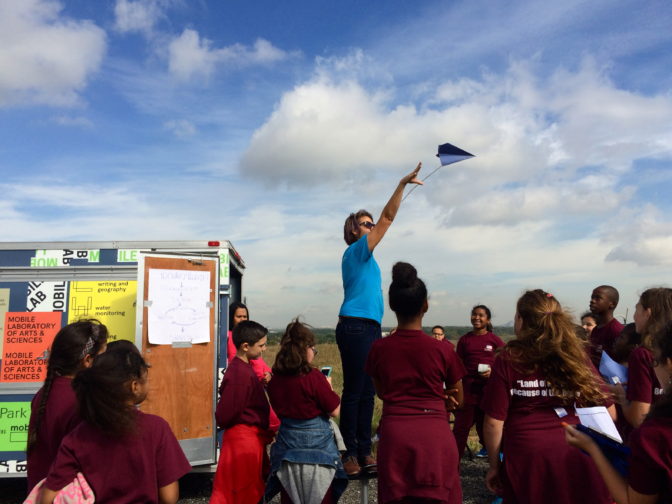A Look Back at Fall 2016 Field Trips

Jessa Orluk helps students test their seed dispersal designs during a field trip at the park.
Written by Jessa Orluk, Freshkills Park Programming Associate.
One Wednesday morning this past October, I led a group of ten students down a path next to Freshkills Park’s Main Creek. I talked as we meandered. The walk was meant to orient students to the park’s ecosystem before we returned to the kayak launch. There, students would test water samples from the creek for salinity, pH and different nutrients.
This path along Main Creek is one my favorites. North Park’s gentle slope rises on the left. Main Creek flows a few feet from the path. The grass here is allowed to grow until late autumn. By then, the invasive reed phragmites is well over five feet tall. Smaller plants strive to fill in what little space is left. The vegetation is so full that walking here feels more like walking through a tunnel instead of hiking in the middle of a meadow.
This particular morning, the grass on our right started rustling. Two small doe popped out ten feet from the group. Students squealed—first because they were afraid, then because they thought the deer were cute. The deer leapt across the road, scrambling away from the noises we were making.
A meeting like this is one benefit of place-based education. The information isn’t abstract. After their close encounter with the two doe, students suddenly had more questions about mammals at Freshkills. Do other mammals live here? Where do the deer come from? Why were they by the water? While I can’t guarantee the resident deer will make an appearance during every field trip, I know that learning in closed sections of Freshkills Park is bringing the landfill-to-park transformation to life in many (sometimes unexpected) ways.
The 397 students who visited Freshkills Park this fall would agree with me. This fall, we had ten different classes visit the Park. Some were from Staten Island schools and others as far away as the Bronx. Some learned how to sketch and identify Freshkills’ native plants. Others learned about the political history of Freshkills by simulating the advocacy done by community groups attempting to close the landfill. Each trip included a 30-40 minute guided walk, so students could observe the landscape on their own.
The Freshkills Park staff are grateful to all of the educators, chaperones, staff and students that participated in a field trip this past fall. Based on the feedback we collected, students overwhelmingly liked engaging with Freshkills through activities, experiments or nature walks. Educators said the same, praising how students were able to deeply engage with the activities provided.
Spring field trips will be announced in January. The best way to stay up-to-date is by subscribing to the Freshkills Park newsletter. In the meantime, we encourage educators have their students experience Freshkills through our online resources.




